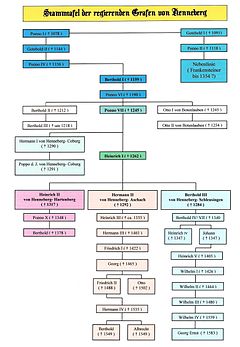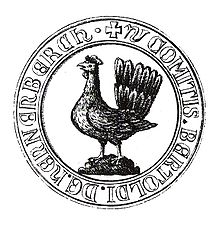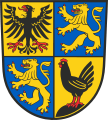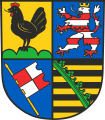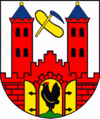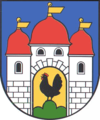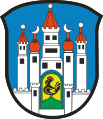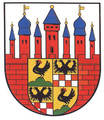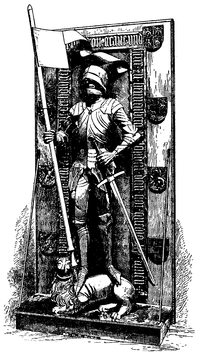- House of Henneberg
-
(Princely) County of Henneberg
(Gefürstete) Grafschaft Henneberg (de)State of the Holy Roman Empire ← 
c. 1037–1660  →
→
 →
→
 →
→Coat of arms
County of Henneberg around 1350 Capital Henneberg
Schleusingen
RömhildGovernment Principality Historical era Middle Ages, Renaissance - Poppo I, first count c. 1037 - Internally divided 1274 - Raised to principality 1310 - Joined
Franconian Circle1500 - Schleusingen branch
extinct1583 - Divided 1660 The House of Henneberg was a cadet branch of the medieval House of Babenberg, which was very powerful in northern Franconia particularly in the 11th, 12th and 13th century. Upon the extinction of the line in the 16th century, most of its territory was inherited by the Saxon House of Wettin and subsequently incorporated into the Thuringian estates of the Ernestine branch.
Contents
Geography
In the 11th century, the dynasty's estates around the ancestral seat Henneberg Castle belonged to the German stem duchy of Franconia, located southwest of the Rennsteig ridge, then forming the border with the possessions held by the Landgraves of Thuringia. Upon the death of Landgrave Henry Raspe in 1247, the Counts of Henneberg at Schleusingen acquired the Thuringian lordship of Schmalkalden, and after the extinction of the Counts of Andechs inherited the Franconian lordship of Coburg (later Saxe-Coburg) in 1260. In 1343 they also purchased the Thuringian town of Ilmenau.
After the Imperial reform of 1500, the County of Henneberg formed the northernmost part of the Franconian Circle, bordering on the Upper Saxon Ernestine duchies and the lands of the Upper Rhenish prince-abbacy of Fulda. A thorn in the side remained the enclave of Meiningen, a fief held by the Bishops of Würzburg, which was not acquired by the counts until 1542.
House of Henneberg 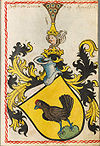
Country Franconia, Thüringia Ancestral house House of Babenberg in turn from the Robertian Dynasty Titles Princely Count of Henneberg Origins
The distant origins of this family are speculative yet seem to originate in the Rhine Valley, east of modern-day France. Charibert, a nobleman in Neustria is the earliest recorded ancestor of the family, dating before 636. Five generations pass between Charibert and the next descendant of note, Rutpert (Robert) I, Count of Rheingau and Wormsgau. Both the Capetian dynasty and the Babenberger (or Popponen) are direct male lineal descendants of Count Robert I and therefore referred to as Robertians.
Robertian family branches
Noblemen in Neustria and their descendants (dates uncertain):
- Charibert († until 636)
- Chrodobertus (Robert) I (from 636), officer of King Dagobert I
- Lambert (Lantbertus) I († until 650)
- Chrodobertus (Robert) II (from 650), maior domus of King Clovis II in 653, cancellarius of King Chlothar III in 658, comes palatinus in 678
- Rupert († 718) Bishop of Worms and first Bishop of Salzburg from 697
- Lambert II († until 741), comes in Neustria and Austrasia
- Chrodobertus (Robert) II (from 650), maior domus of King Clovis II in 653, cancellarius of King Chlothar III in 658, comes palatinus in 678
- Lambert (Lantbertus) I († until 650)
- Chrodobertus (Robert) I (from 636), officer of King Dagobert I
Counts (comes) in the Rheingau and Wormsgau:
- Rutpert (Robert) I († until 764), son of Lambert II, dux in Hesbaye 732, comes palatinus in 742, comes in 750
- Robert II of Hesbaye († July 12, 807), Lord of Dienheim in 795
- Robert III of Worms
- Robert IV the Strong († September 15, 866), Margrave in Neustria
Progenitor of the House of Capet (Kings of France) and the Capetian dynasty
- Robert IV the Strong († September 15, 866), Margrave in Neustria
- Robert III of Worms
- Ingerman of Hesbaye
- Cancor († after 782), Count in the Upper Rheingau (probably also Thurgau) in 745, Count in Breisgau 758, Count in Zürichgau 775/778; established Lorsch Abbey in 764
- Heimrich (Heimo), († May 5, 795 near Lühe at the Elbe river) 772/782 Count in the Upper Rheingau, 778 Count in Lahngau, 784 Abbot of Mosbach
- Robert († 805)
- Heimrich (Henry)
- Poppo I of Grabfeld, 819 Count in Saalgau
Progenitor of the Franconian Babenberger (Popponen) dynasty including the House of Henneberg.
- Poppo I of Grabfeld, 819 Count in Saalgau
- Heimrich (Heimo), († May 5, 795 near Lühe at the Elbe river) 772/782 Count in the Upper Rheingau, 778 Count in Lahngau, 784 Abbot of Mosbach
- Robert II of Hesbaye († July 12, 807), Lord of Dienheim in 795
Babenberger (Popponen)
Counts in Saalgau.
- Poppo I of Grabfeld
- Henry of Franconia
- Poppo II of Thuringia
- Adalbert († 915)
- Poppo III († 945)
- Poppo IV
- Otto I († 982)
- Otto II
- Gerberga, married Otto III, Duke of Swabia
- Poppo V, abbot of Lorsch and Fulda in 1005
- Otto III
- Count Poppo I of Henneberg
- Otto II
- Egino of Thuringia
The denotion Babenberger, named after the castle of Bamberg (Babenberch), was established in the 12th century by Otto of Freising, himself a member of the Babenberg family. The later House of Babenberg, which ruled what became the Duchy of Austria, claimed to come of the Popponen dynasty. However, the descendance of the first margrave Leopold I of Austria († 994) remains uncertain.
Counts of Henneberg
The progenitor Poppo adopted the name in reference to his fortress, Henneberg Castle. A supporter of King Henry IV against Rudolf of Swabia, he died at the 1078 Battle of Mellrichstadt. His successors were:
- Gotebold II († 1144)
- Poppo IV († 1156)
- Berthold I. († 1159), married Bertha von Putelendorf
- Irmingard, married Conrad, Count Palatine of the Rhine
- Poppo VI († 1190)
- Poppo VII († 1245), married Jutta, daughter of Landgrave Herman I of Thuringia
- Herman I († 1290), Count of Henneberg-Coburg, married Margaret, daughter of Floris IV, Count of Holland
- Heinrich I († 1262)
- Poppo VII († 1245), married Jutta, daughter of Landgrave Herman I of Thuringia
- Berthold I. († 1159), married Bertha von Putelendorf
- Poppo IV († 1156)
In 1274 Heinrich's sons divided the county forming the cadet branches:
- Henneberg-Hartenberg, ruled by Heinrich II († 1317) and his successors
- Poppo X (1317–1348)
- Berthold (1348–1378), line extinct, acquired by Henneberg-Aschach-Römhild
- Poppo X (1317–1348)
- Henneberg-Aschach-Römhild, ruled by Herman II († 1292)
- Henry III (1292–1352)
- Herman III (1352–1403), acquired Hartenberg
- Frederick I (1403–1422)
- George (1422–1465), married Johanetta, daughter of Philipp I of Nassau-Weilburg
- Frederick II (1465–1488)
- Herman IV (1488–1535)
- Berthold (1535–1549), line extinct, estates acquired by Saxe-Coburg and County of Stolberg
- Herman IV (1488–1535)
- Frederick II (1465–1488)
- George (1422–1465), married Johanetta, daughter of Philipp I of Nassau-Weilburg
- Frederick I (1403–1422)
- Herman III (1352–1403), acquired Hartenberg
- Henry III (1292–1352)
- Henneberg-Schleusingen, ruled by Berthold III († 1284)
- Berthold IV (1284–1340), raised to a prince by Emperor Henry VII in 1310
- Elizabeth, married John II, Burgrave of Nuremberg
- Henry IV (1340–1347)
- Katharina, married Frederick III, Landgrave of Thuringia
- Elizabeth, married Eberhard II, Count of Württemberg
- John († 1347)
- Henry V (1347–1405), married Matilde, daughter of Rudolf VI, Margrave of Baden
- William I (1405–1426)
- William II (1426–1444)
- William III (1444–1480)
- William IV (1480–1559), married Anastasia, daughter of Albert Achilles, Elector of Brandenburg
- George Ernest (1559–1583), married Elizabeth, daughter of Christoph, Duke of Württemberg
- William IV (1480–1559), married Anastasia, daughter of Albert Achilles, Elector of Brandenburg
- William III (1444–1480)
- William II (1426–1444)
- William I (1405–1426)
- Henry V (1347–1405), married Matilde, daughter of Rudolf VI, Margrave of Baden
- Berthold IV (1284–1340), raised to a prince by Emperor Henry VII in 1310
Disestablishment
Whereas the male line of the House of Babenberg became extinct in 1246, the Counts of Henneberg lived on until 1583. In 1554 William IV of Henneberg-Schleusingen had signed a treaty of inheritance with Duke John Frederick II of Saxony. However, when the last Count George Ernest of Henneberg died, both the Ernestine and the Albertine branch of the Wettin dynasty claimed his estates, that were finally divided in 1660 among the Ernestine duchies of Saxe-Weimar and Saxe-Gotha and the Albertine duke Maurice of Saxe-Zeitz. After the 1815 Congress of Vienna the former Albertine parts around Schleusingen and Suhl fell to the Prussian province of Saxony. King Frederick William III of Prussia assumed the title of a Princely Count of Henneberg, which his successors from the House of Hohenzollern bear ever since.
Notable members of the Henneberg Family
- Bertold von Henneberg-Römhild (1442 - December 21, 1504), Prince-elector and archbishop of Mainz, son of George, count of Henneberg-Römhild.
- Count Otto von Henneberg, known commonly as Otto von Botenlauben from 1206, probably born in 1177 in Henneberg, died near Bad Kissingen before 1245, was a German minnesinger, crusader and founder of Frauenroth Abbey.
Coats of arms incorporating Henneberg
See also
- Bishopric of Würzburg
- Vessra Abbey
- Aura Abbey
- Römhild
- Sondheim
- Münnerstadt
- Irmelshausen
- Bad Kissingen (district)
- Poppo
- William II, German Emperor/Scraps
- Schmalkalden-Meiningen
- Wartburgkreis
- Hildburghausen (district)
- List of states in the Holy Roman Empire (H)
Literature
- Schwennicke, Detlev. Europäische Stammtafeln: Stammtafeln zur Geschichte der Europäischen Staaten, Neue Folge. [European Family Trees: Family Trees for the History of European States, New Series.] BAND II, Tafel 10:Die Robertiner I und die Anfänge des Hauses Capet, 922-923 König der Westfranken, Marburg, Verlag von J.A. Stargardt (1984)
- Historische Landkarte: Grafschaft Henneberg 1755 mit den Ämtern Schleusingen, Suhl, Kühndorf mit Bennshausen, Reprint 2003, Verlag Rockstuhl, ISBN 3-936030-15-4
- Johannes Mötsch: Regesten des Archivs der Grafen von Henneberg-Römhild. Volumes 1 und 2. Böhlau, Köln etc. 2006, ISBN 978-3-412-35905-8
German Wikipedia links
- (German) Direct male descent of Babenberger from Robertiner (Capet) family, in the German Wikipedia
- (German) Early Babenberger genealogy, in the German Wikipedia
External links
 Franconian Circle (1500–1806) of the
Franconian Circle (1500–1806) of the  Holy Roman Empire
Holy Roman EmpireEcclesiastical 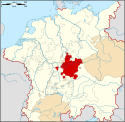
Secular Ansbach · Bayreuth · Henneberg (Römhild, Schleusingen) · Hohenlohe-Waldenburg · Löwenstein-Wertheim · SchwarzenbergCounts / Lords Cities Categories:- Former countries in Europe
- States of the Holy Roman Empire
- States and territories established in 1037
- States and territories disestablished in 1660
- House of Henneberg
- German noble families
- Noble families of the Holy Roman Empire
- House of Babenberg
- Charibert († until 636)
Wikimedia Foundation. 2010.




